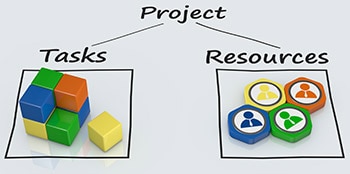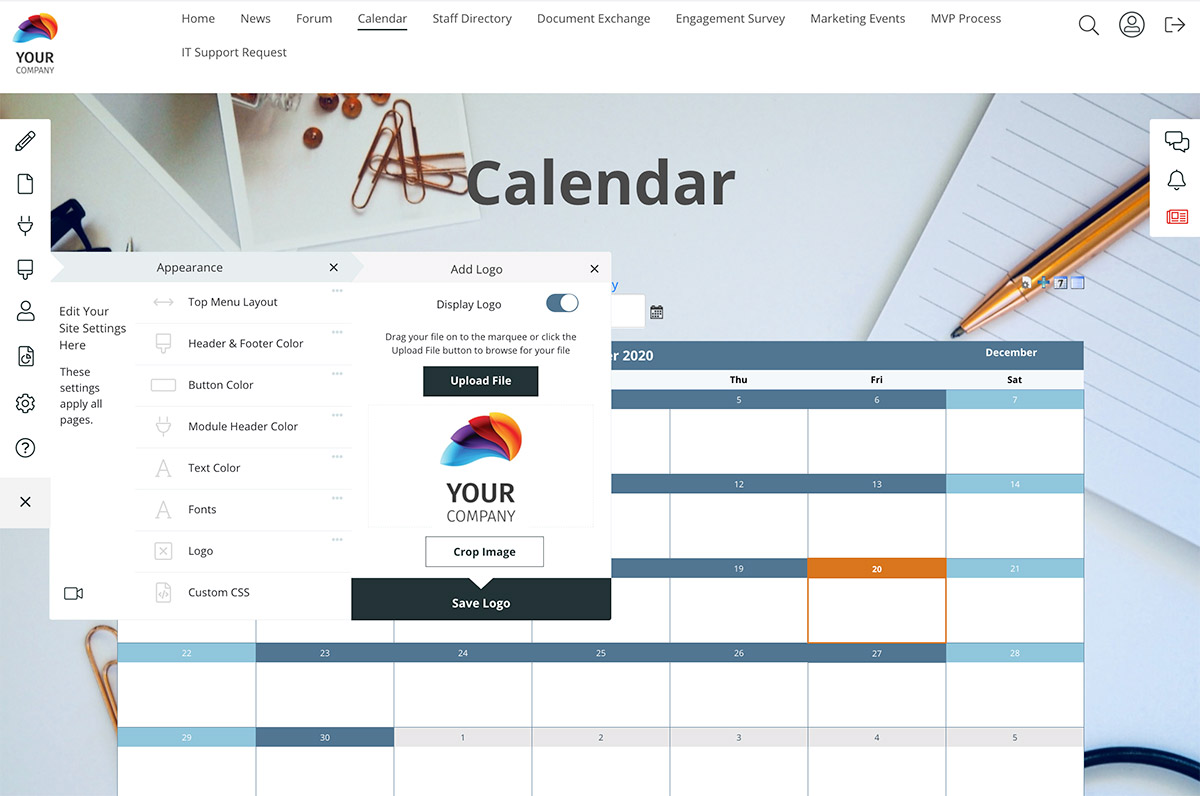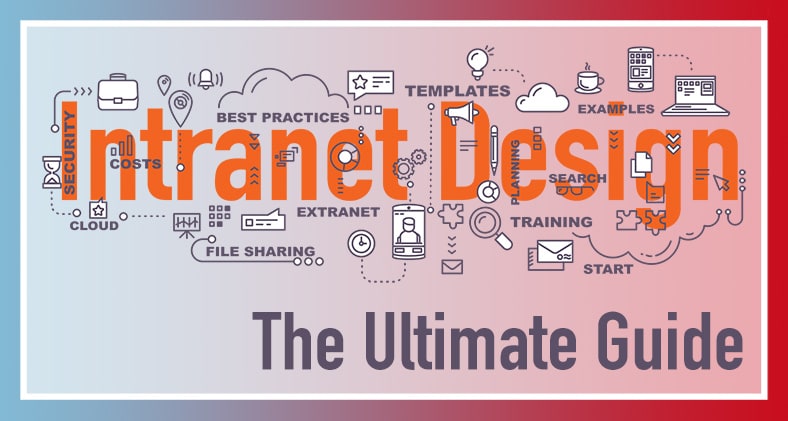When it comes to intranet services, what’s the best option? Should you do it yourself or hire an intranet developer? If you have been charged with delivering your organization’s intranet, then no doubt you have been grappling with this question.
In this post, we will help you identify the answer that’s right for your business.
Every project has to work within different constraints that shape the way it is delivered. One of the best ways to model project constraints is the project management triangle, also known as the iron triangle.
So, let’s look at each point of the triangle and consider whether it’s best to do it yourself or hire an expert.
Time Is Precious
In every business, time is a precious commodity. The amount of time available is likely to be a significant constraint of your intranet deployment project. With that in mind, we recommend the most important first step is to define the objectives. A clear sense of purpose and direction will save you time in the long run.
For most businesses, the impetus behind the intranet is to resolve an identified pain point. For some, it’s improving internal communications or organizational knowledge management. And for others, it’s a need to increase employee engagement and create opportunities for collaboration.
Often the driving force is a business-driven outcome. For example, the intranet is introduced to reduce communication costs and streamline processes before launching your new product.

And how much time you have will, in turn, influence your decision to do it yourself or use an expert. The bottom line is that developing an intranet from scratch takes time. And this is especially so if you don’t have an internal IT resource.
Even if you use open-source software like WordPress to develop your do-it-yourself intranet, it’s still a labor-intensive process. Furthermore, the likes of WordPress and SharePoint were not designed for creating intranets. WordPress, for example, was initially created as a web development tool.
Technical know-how is needed to navigate your way through the many plugins and add-ons required to create your intranet. And this all takes time.
And when it comes to hosting your intranet onsite, don’t underestimate the time factor involved. In addition to taking up physical space in the workplace, maintaining a server takes time. That’s precious staff time that could be better spent on other tasks.
It may be that your business has an internal IT team that you could draw on to deploy the intranet. However, what if your IT team is fully committed to other projects for the next six months? The pain point the intranet was set to resolve will still be festering away in the background. In this context, engaging external help could be the way to go. An intranet developer means you can press ahead with introducing the intranet and start enjoying the benefits.
And if that all-important product launch is scheduled for three months, then using an intranet developer makes sense. External help will ensure the intranet is up and running in time to support the product launch.
However, if the timeframe is not so pressured and you have the internal resources, the do-it-yourself option is worth considering. For many businesses, the possibility of tailoring the intranet to meet their specific needs is very appealing.
People And Resources
For a successful intranet deployment, you need to have the right people and resources in place.
Do you have an in-house intranet expert? If you do, then great, you can probably press ahead with the do-it-yourself option. However, for many small businesses, this simply isn’t an option.
You wouldn’t dream of rewiring the electrics in the workplace without first engaging an electrician. Similarly, it makes sense to use the expertise of an intranet developer in getting your project off the ground.
The intranet developer has a wealth of knowledge and experience in developing and delivering intranets. And they bring specialist expertise in functionality and troubleshooting.

Most companies find setting up an intranet from scratch takes several months from start to finish. And even off-the-shelf options like WordPress require some technical knowledge and an investment of time.
Furthermore, do-it-yourself options also mean you are responsible for testing the software. Before your intranet can go live, you need to test it thoroughly with a group of employees. You want to be sure the tools and modules are fit for purpose. And you want to be sure the UX, site navigation and search function are pitched at the right level.
In our experience, any meaningful pilot has to run for at least six weeks. That gives you plenty of time to assess the platform in the workplace and obtain meaningful feedback. You will also need to allow time to make any changes to the software in light of the pilot.
It’s easy to see how the costs associated with a do-it-yourself implementation can quickly spiral out of control. And that’s without factoring in the number of employees who will be tied up in the implementation. Or the requirement for company servers to host the intranet and the expense of ongoing maintenance.
Often, a more efficient use of resources is to engage an intranet developer. They can save you time and help to keep the costs down. Experienced and knowledgeable intranet developers know all the potential pitfalls. They will ensure the requirements for your intranet project are appropriate for your business needs.
Furthermore, most intranet developers offer cloud-hosted solutions. This means you don’t have to worry about purchasing and maintaining additional company servers. That particular headache remains the responsibility of the hosting company.
Also taken care of is the whole issue of intranet security. With a do-it-yourself intranet, online security and safeguarding your confidential data is your responsibility. From encryption to firewalls and anti-virus protection, keeping on top of the latest threats and countermeasures is up to you.
However, select an intranet developer option, and online security, backups, and updates become their responsibility. Your intranet will be as safe and secure as possible with all the latest security features.
Furthermore, intranet developers usually offer pre-built and pre-tested intranet design templates. These already come with coding and a basic design. Using a straightforward setup wizard, you drag and drop content and images for a customized solution.
There are a variety of intranet templates you can select. Popular options include the following:
- Newsfeeds and blogs – keep everyone updated with critical company or team news.
- Staff directory – connect employees and facilitate collaboration with an online directory and engaging staff profiles.
- Automated forms – streamline businesses processes and approvals with digital forms and workflows.
- File and document storage – set up a secure document exchange were users can find company templates and files or work collaboratively on documents.
- Team chat – speed up decision-making and promote team spirit and company culture with instant messaging.
- Forums and project spaces – private workspaces where teams can share information and data, problem-solve, work collaboratively, or track progress on projects.
- Social intranet features – @mentions, activity walls, and sharing of updates among staff.
- Quizzes and surveys – whether formal or fun, ask employees’ views on the hot topics of the day and gain insights on what’s important to help with decision-making.
All you need to do is select the functionality your business needs. You then customize the templates with your branding and logo, plus content and images.
The intranet provider will have lots of other clients using the same basic design templates. However, customization means they are all different, and yours will be a unique platform.
It also means that you have access to the testimonies of other companies just like yours. You can check that the intranet does the job. And perhaps more importantly, that it does the job exceptionally well.
The bottom line is there are plenty of economies of scale to be had with an intranet developer. You will soon discover they have done all the hard work for you already, making for a smoother, hassle-free implementation.
A word of caution though, beware of using website developers to set up your intranet. Usually, website developers are not intranet experts. They may well be great at developing websites and apps, but they don’t always understand the intranet’s ins and outs. And they may not have a full grasp of the organizational pain points you are seeking to address.
Intranet Services And Value For Money
Making sure your intranet offers value for money is another constraint impacting your intranet project. Undoubtedly, there will be organizational pressure to ensure the intranet offers enough return on investment.
If you are going down the do-it-yourself route, make sure you have considered all the potential costs. And the expenses don’t just start and end with the software. There are plenty of hidden costs that you may not have fully appreciated. These include the following:
Employee training and development program to upskill staff on the new platform
- Cost of add-ons and plugins to ensure the functionality you require
- Development and testing of the pilot intranet
- Purchasing and maintaining additional company servers.
In comparison, an intranet developer and cloud solution offer greater cost certainty. Clear terms of engagement set out the roles and responsibilities of the intranet developer and the fees involved. Cloud hosting also works out to be very cost-effective with fixed monthly fees, unlimited numbers of users, and data storage. For small businesses, in particular, the cost certainty offered by intranet providers is a huge advantage.
No One-Size Solution
For many companies, employing an intranet expert to deliver the overall solution is an effective use of resources. It saves valuable time and with greater cost certainty, staying within budget becomes a whole lot easier.
Pre-built intranet design templates are now so easy to use that for many businesses, they are the perfect solution.

However, it’s a different story when trying to do it yourself. In this case, the lead-in can be several months. It’s also labor-intensive. Large numbers of employees could potentially be diverted from other critical tasks during development and implementation.
What’s more, the services of an intranet developer come at a very competitive price. This is an excellent option for time-poor businesses wanting a quick intranet deployment to meet an organizational pain point.
For companies with the will, resources, skilled personnel, and time on their side, a bespoke intranet can be a good choice.
However, if you are looking for an easy-to-implement intranet solution, then get in touch with us here at MyHub. Let us take on the stress and hassle of implementing your intranet.
We are the number one choice for hundreds of businesses of different sizes and various markets worldwide. Find out why with our free intranet demo or sign up for a no-obligation 14-day trial. Contact us today and get started on your intranet solution.
How An Intranet Works
Before we take a deep dive, let’s get back to basics with an explanation of how an intranet works.
An intranet is an internal website accessible only to employees. Like the internet, it uses the transmission control protocol/internet protocol communications standard to connect hosts and users over a LAN. And remote workers can securely log in either using a VPN and/or by using IP whitelisting, making intranets perfect for hybrid workplaces and on-the-go employees.
Intranets use programming languages like HTML, Java, or XML to develop web pages with text, images, video, and audio. These web pages are then displayed to the user just like internet-based sites.
Some organizations allow clients or partners limited access to their intranet outside the LAN. Think graphic designers, accountants, and lawyers sharing information and data with customers. These arrangements are called extranets.
Another variation of intranets is portals. A portal is a gateway allowing access to external enterprise systems and apps. The most common ones are CRM platforms like Salesforce or HR management systems. Portals ensure your people seamlessly access enterprise systems directly from the intranet.
Intranets are flexible platforms that simultaneously address a host of business functions. The end result is improved productivity and efficiency across the board. Here are just a few highlights:
- Internal communications
- Knowledge management
- Team collaboration
- Streamlined processes
- Employee engagement
- Hybrid working
With so many fantastic benefits, it’s no surprise that intranets are the number one choice for digital workplaces.
Custom-Built Intranet Development
When it comes to developing a bespoke intranet, the typical process for a web development agency involves several steps. These include the following:
Requirements Gathering
The first step is gathering information on the client’s requirements and undertaking a needs analysis. This stage involves answering the following questions:
- What does the client want their intranet to achieve?
- What key features and business tools are relevant?
- What are the baseline requirements for data and information?
Often the driving force is a pain point or issues the business is facing that needs to be resolved. It could be:
- Poor internal communications
- A need for faster and more accessible information and data sharing
- A desire to increase productivity with more streamlined processes
- Problems with departmental information silos
The needs and the solution will vary, so you must have a firm handle on the driving force for an intranet. This step may involve conducting focus groups, staff questionnaires, or workshops. And these will take time to complete.
Information Architecture
Now it’s time to sketch the information architecture for the intranet. You need to identify the site’s main topics and subtopics, all the business processes, information, and data flow diagrams. This step also involves creating an initial sitemap, thumbnails, outlines, and a table of contents.
Design
Next is the overall look and feel of the site. The client will no doubt have views about site design. You will need to work closely with the customer at this stage, which involves a significant investment of time.
During this step, the page grid, page design, and overall graphic elements are created and agreed on. The interface design, all illustrations, and photography are also finalized.
Development
Developing a prototype is next in the process. This ensures the client gets a good feel for the end product and how information will be delivered. From the developer’s perspective, the prototype confirms that the platform meets the organization’s goals and is fit for purpose. It’s also an opportunity to test the site navigation and develop the user interface.
Testing
The final step in the intranet development process is testing. The software will need to be extensively tested for the following:
- Functionality
- Code quality
- Speed
- Ease of use
- Ongoing management
- Reliability
- Compatibility
- Mobile optimization
- Appeal to end users.
As well as ensuring the software is fully functional, you also want confirmation that it meets end users’ needs. This includes visual appeal, ease of use, and achieving the intranet’s overall objectives. Therefore, people not directly involved in the development must complete the testing phase. Internal colleagues or a sample of users from the customer’s business is ideal. Testers should report back on any issues, including programming bugs, broken site links or online forms, and proofreading errors. Furthermore, they should provide feedback on overall design and effectiveness.
As you can see, the bespoke intranet development process is time and labor-intensive. It requires a significant investment from you and the client. Only some companies are willing to make that investment. Moreover, there is inherent risk involved for the web development agency. Even after thoroughly going through all these steps, there are no guarantees that the client will proceed.
Hosted CMS Solutions
By contrast, this option is far less risky for web development agencies. And for the client, it’s a quicker and simpler process. For example, it takes some MyHub customers only three days to launch their platform. For most companies, an identified pain point is the impetus behind an intranet. So, the ability to resolve that issue quickly with a fully functioning intranet will be of great interest to clients.
What’s more, CMS intranets are easily scalable. As the customer’s business grows, so does the platform. Adding users, content, and modules is effortless.
The bottom line is that CMS intranets offer a streamlined, more cost-effective solution for consultants and clients. To demonstrate this, let’s take a deep dive into the intranet development process for CMS intranets.
CMS Intranet Development
Requirements Gathering
Rather than starting from a blank sheet of paper, this time, there is an extensive range of functions and tools in-built into the software. Take your pick from the following:
- news feeds and blogs
- document management and sharing systems
- automated business processes, and online forms
- interactive employee profiles
- instant messaging
- project or team collaboration spaces
- social intranet features
The truth is that these tools have been developed in response to a broad range of organizations and business needs. Whatever the pain point driving intranet adoption, the in-built features will appeal to most businesses. This approach also has the advantage of framing the client’s expectations upfront about what is achievable. Moreover, it reduces the web development agency’s exposure to the inherent risk of bespoke solutions. Instead, matching functionality against the organization’s needs is relatively easy.
Information Architecture
Pre-built templates eliminate the need to spend a lot of time developing extensive content architecture. A basic sitemap and navigation already exist with powerful modules ready to customize for customers’ needs. And you can make it personal with corporate colors, fonts, and logos.
However, the real beauty of page templates is simplicity. Adding or editing pages and modules is straightforward, reducing the need for extensive pre-planning. It’s also empowering for clients because they can change things around and modify as business requirements shift. And the drag-and-drop functionality means they won’t need a college degree in computing!
Design
Intranet templates have flexible page layouts and options that reflect the latest design best practices. Adding and editing text, images, graphics, videos, and files is a breeze. Customization options mean that even though you use a template, the intranet is unique to your customers’ business and brand.
With all the complex design work taken care of, you have more time to ensure the platform addresses your customers’ pain points.
Development
The development stage is streamlined with a free trial, shared screen tour, or no-obligation demo. Most providers allow customers to test drive the product before signing on the dotted line. There’s no intranet software to install or learning curve involved. The powerful intranet templates already come with basic navigation and site graphics. The simple step-by-step builder with flexible design and page options enables clients to go live within days. Moreover, templates are easy to maintain and deliver a consistent look and coherent navigation throughout the site.
Testing
With this option, all the pre-testing has been done. The web consultant and customer can be confident that it does what it says on the box. Furthermore, CMS intranet templates are regularly tweaked and updated, reflecting the actual experiences of thousands of users. Plus, the design is already optimized for the smaller screens of smartphones and tablets. The customer is assured of mobile functionality.
Pre-testing saves time and plenty of dollars. As a web consultant, you can provide intranet development services more competitively than industry rivals.
And with no setup or ongoing management and maintenance costs, it’s more cost-effective. All of this is covered in a fixed monthly fee, enabling you to provide customer costings more accurately and confidently. Moreover, CMS intranets have proven high availability, uptime, and CPU speeds. The MyHub intranet, for example, typically has 99.9 percent availability and uptime.
It’s an easier sell for consultants when users already utilizing the product can verify that it does the job exceptionally well.
Benefits Of Cloud-Hosted Intranets
Cloud-hosted intranets offer many extra welcome benefits for your customers. Rather than purchasing additional servers and hosting and maintaining their intranet, it’s outsourced to a hosting company. The benefits include:
- Up-to-date security features
- Fixed monthly costs
- Unlimited users
- Automatic updates and backups.
CMS intranets offer none of the unknowns of bespoke versions. And so, they give customers a better return on investment. And it means less risk for the developer.
From the consultant’s perspective, you can focus more on understanding and delivering against the customer’s requirements. Positioning your agency as responsive and able to deliver gives you a competitive edge. Other agencies may focus more on maximizing the billed hours and revenue raised from intranet development.
And the intuitive, easy-to-follow setup and ongoing management of the templates mean intranet deployment is streamlined. Clients can get started faster and realize the benefits in days rather than weeks or months.
Partner With MyHub Intranet Solutions
Meet your needs and those of your customers by partnering with MyHub. Consistently rated highly on independent review sites, we offer much more than intranet software. We streamline the intranet development process and ensure end-user activities are better aligned. Our platforms are used by intranet development businesses and a wide variety of organizations worldwide. Here are just some of the reasons why.
1. Experience
We’ve been in business for over 20 years and have an unmatched wealth of expertise. We have done it all, from very simple to highly complex, customized platforms.
2. Readily Accessible Support
When it comes to support, not all suppliers are created equal. We work alongside you at every stage, including developing the design, prototype, and launch. And we don’t just stop there. The MyHub team helps with long-term maintenance.
MyHub also has an extensive online library of resources and explainer videos. Plus, our technicians are available to talk you through any gnarly issues.
Help is always on hand with MyHub.
3. Dedicated Design Service
From frontend to backend development, MyHub’s design service will deliver a fully functioning site in no time. Many off-the-shelf options require you to set up and configure the platform yourself. And for time-pressed business clients, the delay involved will see them looking elsewhere.
Imagine the difference a dedicated design service makes. That’s where MyHub has the edge over others in the market. Our design service removes the complexity and risk for you and your client. We do it all. MyHub’s expert designers will create a customized, working intranet in 40 days or less. Guaranteed.
The process is broken down into three simple stages:
- Scope and commercials: we gather the requirements, define objectives and timelines, agree on the scope of work and develop a sitemap
- Site design: includes customization with branding, colors, and logos. Pages are designed, graphics and images are added, and content is uploaded. A document exchange is created and populated. Finally, users are added, and site permissions are set.
- Launch: the site is now ready to go live. Yay! Handover, training, and post-launch support are included in the service.
MyHub’s design solution is genuinely comprehensive. Our experts are on hand every step of the way. And your clients will be delighted with the speed and responsiveness of the service.
4. Value-Added Services
Here at MyHub, we also deliver a host of value-added services. We advise and support on content migration from other systems. And free site audits, intranet optimization, and post-launch support are also available.
5. Security Guaranteed
Assuring your clients of the security of valuable company data is a top priority. However, we don’t need to tell you how complex security is.
Your customers have to navigate external threats from malware and viruses. And they also need to tackle internal threats. Access control and site permissions are essential. Going it alone is not an option for busy organizations, especially if there’s no internal tech expertise.
With MyHub’s platform, security is guaranteed. Our software comes with firewalls, and two-way SSL encryption, all delivered via Amazon Web Services that meet many industrial security standards, including SOC 2 compliance. That’s one major headache taken care of already.
However, we also maximize internal security. Standard safeguards include forced and automated password resets, easy-to-set page and user permissions, and restricted access based on IP addresses.
In short, you or your customers don’t need to worry about security because we have it covered.
SharePoint Intranets vs. MyHub
Some intranet developers see SharePoint as a good halfway house between bespoke and off-the-shelf. After all, SharePoint is free to download, and as an MS product, it integrates well with Office 365. It comes with a core offering, which you can supplement with plugins for extra functions. And the familiar MS look and feel can be very appealing to customers.
However, SharePoint does have limitations. It’s pretty clunky to set up and use. And for businesses without internal tech expertise, that’s a significant drawback.
Furthermore, the core offering has limited functionality. Most businesses find they need several add-ons to meet their objectives. Often, these plugins come with a price tag. So, what seemed like a cost-effective option quickly becomes an expensive undertaking. Responsibility for upgrading the software rests with the client. And when you have lots of plugins, that’s a confusing and time-consuming job.
Customization options are also limited. It takes work to make a SharePoint intranet on your own. And most often, it ends up feeling like an MS intranet.
Furthermore, there are no add-ons or hidden extras. MyHub’s solution comes with a comprehensive set of pre-built and tested tools, ready to go. The biggest problem is selecting which of our extensive choice to run with.
Our intranet templates are fully customizable for a platform that’s unique every time. Our pre-built intranets ensure rapid deployment when it counts. And they are scalable. As the business grows, so does the MyHub intranet.
What’s more, security is taken care of with the latest industry-standard protection.
And unlike SharePoint, our expert designers are ready to support you at every stage.
Agency Intranet Development Final Thoughts
Intranet development services from a digital agency can help businesses digitalize their in-house processes and transform their operations. With digital transformation statistics showing that only 8% of companies have digital operations across all divisions, digital agencies are well-positioned to provide specialist knowledge and advice to help other companies digitalize. Moreover, an intranet development agency can offer complete solutions for digitalizing business processes, with the latest technology and well-defined processes to ensure success. Here lies a great opportunity for the intranet development partners who will analyze the specific needs of each organization, recommend appropriate adaptations for their business model, and implement customized solutions that maximize efficiency and streamline internal communication.
Looking for an intranet solution that simultaneously meets the needs of customers and your web development agency? Sign up today for MyHub’s free demonstration or no-obligation 14-day trial period and discover how our software makes intranet development effortless.



 Employee training and development program to upskill staff on the new platform
Employee training and development program to upskill staff on the new platform









